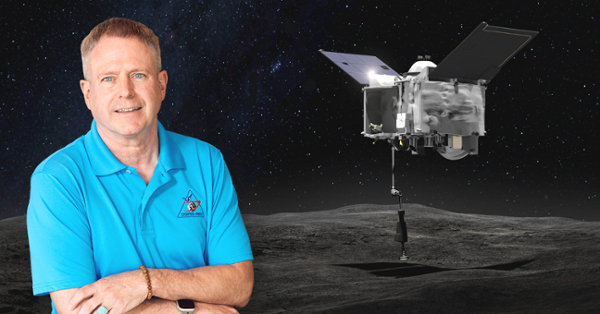Answering ancient questions, Connolly leads NASA asteroid study
Answering ancient questions, Connolly leads NASA asteroid study

A journey of some two billion miles by NASA’s OSIRIS-REx spacecraft ends Sept. 24 in the Utah desert, bringing with it space rocks that scientists hope may unravel some of the mysteries of the Solar System.
Leading research into the spacecraft’s return sample will be Dr. Harold Connolly Jr., a petrologist and cosmochemist who chairs Rowan University’s Department of Geology.
Connolly, who holds titles on the NASA mission of co-investigator and mission sample scientist, will supervise analysis by a 250-member international team studying the sample from Bennu, a potentially hazardous carbonaceous asteroid that the spacecraft rendezvoused with 200 million miles from Earth.
OSIRIS-REx, which launched in September 2016 from Cape Canaveral in Florida, completed a highly technical “touch and go” procedure above Bennu’s surface Oct. 20, 2020, in which the vessel extended a robotic arm, expelled a burst of nitrogen to loosen the surface, and collected the sample for passage back to Earth.
Even before the spacecraft’s return, Connolly said, scientists have been learning a great deal about Bennu, including that it has a surprisingly crumbly structure.
“We never knew the asteroid would be so loosely held together,” he said.
NASA embarked on the mission so scientists can study a sample from space that, unlike meteorites that crash through Earth’s fiery atmosphere, will be pristine.
Though OSIRIS-REx is NASA’s first asteroid sample collection mission, it was not humanity’s first. Japan’s JAXA space agency successfully retrieved samples during the Hayabusa1 and Hayabusa2 missions, the latter of which Connolly also served in.
OSIRIS-REx will deliver to Earth the largest asteroid sample ever collected by a spacecraft. The sample return capsule is estimated to hold about a cup, 8.8 ounces, of Bennu's material.
Connolly said scientists expect to publish 120 or more papers from research conducted on the sample, some of which may unlock some of the greatest mysteries in the Solar System. By studying the sample from Bennu, he said, scientists hope to learn not just about how that carbonaceous asteroid formed 4.5 billion years ago but, possibly, about the origin of Earth.
“One of the things we’re trying to determine is where did life come from?” he said. “In order for there to be life as we know it, you need an atmosphere, you need water, but first you need a planet.”
Perhaps even more important, he said, by studying the sample from Bennu, scientists hope to learn more about how asteroids behave and how to prevent them from hitting Earth.
The sample analyses will be highly complex but scientists will study just a portion of it, preserving roughly 75 percent of the recovered material.
“Future generations may have better ways of analyzing it,” Connolly said.
A continuing mission
After ejecting the sample during a flyby of Earth, OSIRIS-REx (Origins, Spectral Interpretation, Resource Identification and Security-Regolith Explorer) will continue on an extended mission to the near-Earth asteroid Apophis, which it’s scheduled to reach in 2029.
In late August, Connolly and other scientists gathered on the secure Utah Test and Training Range where they will retrieve the capsule to test landing and recovery plans. OSIRIS-REx will release the capsule 63,000 miles from Earth into a target area of roughly 250 square miles, a feat, one researcher told media Aug. 30, that’s akin to “throwing a dart across the length of a basketball court and hitting a bullseye.”
During a 2020 broadcast by NASA, OSIRIS-REx personnel said Bennu was chosen out of hundreds of thousands of known asteroids, partly for the smooth, sandy conditions they expected to find on its surface.
It wasn’t until the spacecraft reached its orbit in 2018 and scientists began photographing the asteroid's surface that they learned it was not smooth and sandy but jagged and rocky, and those conditions forced a collection attempt in a spot called Nightingale that was the size of a few parking spaces.
Connolly said surprises like those already revealed by Bennu and the OSIRIS-REx mission make science eternally fascinating.
“I’m an explorer of space, time and the human experience,” he said. “Bennu is more complex than we expected. It’s quite diverse.”